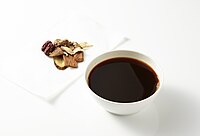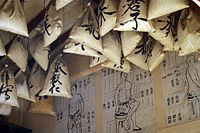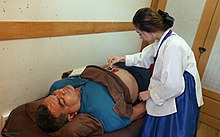A Korean acupuncturist inserting a needle into the leg of a male patient. Wellcome Collection
Traditional Korean medicine are medical practices that originated and developed in Korea.
History
Korean
medicine traditions originated in ancient and prehistoric times and can
be traced back as far as 3000 B.C. when stone and bone needles were
found in North Hamgyong Province, in present-day North Korea. In Gojoseon, where the founding myth of Korea is recorded, there is a story of a tiger and a bear who wanted to reincarnate in human form and who ate wormwood and garlic. In Jewang Ungi (제왕운기), which was written around the time of Samguk Yusa,
wormwood and garlic are described as 'edible medicine', showing that,
even in times when incantatory medicine was the mainstream, medicinal
herbs were given as curatives in Korea. Medicinal herbs at this time
were used as remedial treatment such as easing the pain or tending
injury, along with knowing what foods were good for health. Moreover,
wormwood and garlic are not found in ancient Chinese herbology, showing
that traditional Korean medicine developed unique practices and
inherited them from other cultures.
In the period of the Three Kingdoms, traditional Korean medicine was mainly influenced by other traditional medicines such as ancient Chinese medicine. In the Goryeo
dynasty, a more intense investigation of domestic herbs took place: The
result was the publication of numerous books on domestic herbs. Medical
theories at this time were based on the medicine of Song dynasty, but prescriptions were based on the medicine of the Unified Silla period such as the medical text First Aid Prescriptions Using Native Ingredients or Hyangyak Gugeupbang (향약구급방), which was published in 1236. Other medical journals were published during this period like Introductory Guide to Medicine for the General Public or Jejungiphyobang (제중입효방).
Medicine flourished in the period of the Joseon. For example, the first training system of nurses was instituted under King Taejong (1400-1418), while under the reign of King Sejong the Great (1418-1450) measures were adopted to promote the development of a variety of Korean medicinal ingredients.
These efforts were systematized and published in the Hyangyak
Jipseongbang (향약집성방, 1433), which was completed and included 703 Korean
native medicines, providing an impetus to break away from dependence on
Chinese medicine. The medical encyclopaedia named Classified Collection of Medical Prescriptions
(醫方類聚, 의방유취), which included many classics from traditional chinese
medicine, written by Kim Ye-mong (金禮蒙, 김예몽) and other Korean official
doctors from 1443 to 1445, was regarded as one of the greatest medical
texts of the 15th century. It included more than 50,000 prescriptions and incorporated 153 different Korean and Chinese texts, including the Concise Prescriptions of Royal Doctors (御醫撮要方, 어의촬요방) which was written by Choi Chong-jun (崔宗峻, 최종준) in 1226. Classified Collection of Medical Prescriptions
has very important research value, because it keeps the contents of
many ancient Korean and Chinese medical books that had been lost for a
long time.
After this, many books on medical specialties were published. There are three physicians from the Joseon Dynasty (1392-1910) who are generally credited with further development of traditional Korean medicine—Heo Jun, Saam, and Lee Je-ma. After the Japanese invasion in 1592, Dongeui Bogam (동의보감) was written by Heo Jun,
the first of the major physicians. This work further integrated the
Korean and Chinese medicine of its time and was influential to Chinese,
Japanese and Vietnamese medicine.
The next major influence to traditional Korean medicine is related to Sasang typology (사상의학). Lee Je-ma and his book, The Principal of Life Preservation in Oriental Medicine (東醫壽世保元, 동의수세보원) systematically theorized with the influence of Korean Confucianism and his clinical experiences in Korea. Lee Je-ma
said that even if patients suffer the same illness, patients need to
use different herbal applications to treat the same illness due to the
pathophysiologies of individuals. He stresses that the health of human
body had a close relationship with the state of mind. He believed that
the human mind and body were not separate and they closely reflected
each other, and the aspect of mind needed to be considered when
examining the causes of disease. Thus, not only food and natural
environment but also emotional changes in humans can be another major
reason for illness. He believed that medical diagnosis and treatment
should be based on person's typology rather than on symptoms alone and
each person should be given different prescriptions depending on the
constitution of the individual. Sasang typology
(사상의학) focuses on the individual patients based on different reactions
to disease and herbs. Treat illness by the treatment of the root cause
through proper diagnosis. Key to this diagnosis is to first determine
the internal organs or pathophysiology of each patient.
The next recognized individual is Saam, a priest-physician who is
believed to have lived during the 16th century. Although there is much
unknown about Saam, including his real name and date of birth, it is
recorded that he studied under the famous monk Samyang. He developed a
system of acupuncture that employs the five element theory.
In the late Joseon dynasty, positivism was widespread. Clinical
evidence was used more commonly as the basis for studying disease and
developing cures. Scholars who had turned away from politics devoted
themselves to treating diseases and, in consequence, new schools of
traditional medicine were established. Simple books on medicine for the
common people were published.
Lee Je-ma
classified human beings into four main types, based on the emotion that
dominated their personality and developed treatments for each type:
- Tae-Yang (태양, 太陽) or "greater yang"
- So-Yang (소양, 小陽) or "lesser yang"
- Tae-Eum (태음, 太陰) or "greater yeum"
- So-Eum (소음, 小陰) or "lesser yeum"
Methods
Herbal medicine
Herbalism
is the study and practice of using plant material for the purpose of
food, medicine, or health. They may be flowers, plants, shrubs, trees,
moss, lichen, fern, algae, seaweed or fungus. The plant may be used in
its entirety or with only specific parts. In each culture or medical
system there are different types of herbal practitioners: professional
and lay herbalists, plant gatherers, and medicine makers.
Herbal medicines may be presented in many forms including fresh,
dried, whole, or chopped. Herbs may be prepared as infusions when an
herb is soaked in a liquid or decocted—simmered in water over low heat
for a certain period. Some examples of infusion are chamomile or
peppermint, using flowers, leaves and powdered herbs. Decocting examples
may be rose hips, cinnamon
bark, and licorice root consisting of fruits, seeds, barks, and roots.
Fresh and dried herbs can be tinctured where herbs are kept in alcohol
or contained in a vinegar extract. They can be preserved as syrups such
as glycerites in vegetable glycerin or put in honey known as miels.
Powdered and freeze dried herbs can be found in bulk, tablets, troches
similar to a lozenge, pastes, and capsules.
Non-oral herbal uses consist of creams, baths, oils, ointments,
gels, distilled waters, washes, poultices, compresses, snuffs, steams,
inhaled smoke and aromatics volatile oils.
Many herbalists consider the patient's direct involvement to be
critical. These methods are delivered differently depending on the
herbal traditions of each area. Nature is not necessarily safe; special
attention should be used when grading quality, deciding a dosage,
realizing possible effects, and any interactions with herbal
medications.
An example of herbal medicine is the use of medicinal mushrooms as a food and as a tea. A notable mushroom used in traditional Korean medicine is Phellinus linteus known as Song-gen.
Acupuncture
Acupuncture
is used to withdraw blood or stimulate certain points on humans and
animals by inserting them on specific pressure points of the body.
Traditional acupuncture involves the belief that a "life force" (qi) circulates within the body in lines called meridians. Scientific investigation has not found any histological or physiological evidence for traditional Chinese concepts such as qi, meridians, and acupuncture points, and many modern practitioners no longer support the existence of life force energy (qi) flowing through meridians, which was a major part of early belief systems.
Pressure points can be stimulated through a mixture of methods ranging
from the insertion and withdrawal of very small needles to the use of
heat, known as moxibustion. Pressure points can also be stimulated by laser, massage, and electrical means.
Moxibustion
Moxibustion
is a technique in which heat is applied to the body with a stick or a
cone of burning mugwort. The tool is placed over the affected area
without burning the skin. The cone or stick can also be placed over a
pressure point to stimulate and strengthen the blood.
2013 World Traditional Medicine Expo, Sancheong
A Cochrane Review found limited evidence for the use of moxibustion in correcting breech presentation of babies, and called for more experimental trials. Moxibustion has also been studied for the treatment of pain, cancer, stroke, ulcerative colitis, constipation, and hypertension. Systematic reviews have found that these studies are of low quality and positive findings could be due to publication bias.
Education
Graduate School of Korean Medicine
The South Korean government
established a national school of traditional Korean medicine to
establish its national treasure on a solid basis after the closing of
the first modern educational facility (Dong-Je medical school) one
hundred years ago by the Japanese invasion.
In 2008, the School of Korean Medicine was established inside Pusan National University
with the 50 undergraduate students on the Yangsan medical campus. The
new affiliated Korean Medical Hospital and Research Center for Clinical
Studies are under construction.
Compared with common private traditional medicine undergraduate schools (6 years), this is a special graduate school (4+4).





